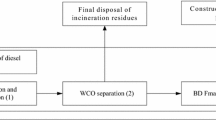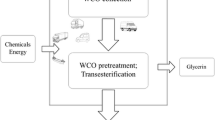Abstract
Waste cooking oil (WCO) can serve as a feedstock for producing biodiesel, which would not only address food security and waste disposal but also has the potential to reduce emissions of greenhouse gas (GHG) and particulate matter of 2.5 μm or smaller (PM2.5). In this study, we assessed restaurant waste oil (RWO) availability in China and conducted life cycle analysis (LCA) of GHG and PM2.5 emissions of RWO-based biodiesel using the GREET model. The results showed that the amount of RWO in China varies between 0.56 and 1.67 million tons in 2013 and between 0.54 and 1.63 million tons in 2014. Life cycle analysis estimated reduction of GHG and PM2.5 emissions through the use of RWO-based rather than petroleum-based biodiesel of 82 kg CO2-Eq. (90 %) and 0.92 g PM2.5 (46 %) respectively per 100 km driven by busses in 2014 in Shanghai, China. Given the total amount of RWO available in 2014 in China, the potential mitigated annual GHG emission ranges, in China, are 1.51 ∼ 4.52 × 106 tons of CO2-eq and 16.94 ∼ 50.83 tons of PM2.5.



Similar content being viewed by others
References
Nas B, Berktay A (2007) Energy potential of biodiesel generated from waste cooking oil: an environmental approach. Energy Sources Part B 2(1):63–71
Lam MK, Lee KT, Mohamed AR (2010) Homogeneous, heterogeneous and enzymatic catalysis for transesterification of high free fatty acid oil (waste cooking oil) to biodiesel: a review. Biotechnol Adv 28(4):500–518
Gog A, Roman M, Toşa M, Paizs C, Irimie FD (2012) Biodiesel production using enzymatic transesterification—current state and perspectives. Renew Energy 39:10–16
Nielsen PM, Brask J, Fjerbae KL (2008) Enzymatic biodiesel production: technical and economical considerations. Eur J Lipid Sci Technol 110:692–700
Supple B, Howard-Hildige R, Gonzalez-Gomez E, Leahy JJ (2002) The effect of steam treating waste cooking oil on the yield of methyl Ester. JAOCS 279(2):175–178
Canakci M (2005) The potential of restaurant waste lipids as biodiesel feedstocks. Bioresour Technol 98:183–190
Wiltsee G (1998) Waste grease resource in 30 US metropolitan areas. The Proceedings of Bioenergy 98 Conference, Madison, WI, pp. 956–963
Zhang Y, Dube MA, McLean DD, Kates M (2003) Biodiesel production from waste cooking oil: 1. Process design and technological assessment. Bioresour Technol 89:1–16
Sheinbaum-Pardo C, Calderón-Irazoque A, Ramírez-Suárez M (2013) Potential of biodiesel from waste cooking oil in Mexico. Biomass Bioenergy 56:230–238
Chua CBH, Lee HM, Low JSC (2010) Life cycle emissions and energy study of biodiesel derived from waste cooking oil and diesel in Singapore. Int J Life Cycle Assess 15:417–423
Meng XM, Chen G, Wang Y (2008) Biodiesel production from waste cooking oil via alkali catalyst and its engine test. Fuel Process Technol 89:851–857
Bautista LF, Vicente G, Rodríguez R, Pacheco M (2009) Optimisation of FAME production from waste cooking oil for biodiesel use. Biomass Bioenergy 33:862–872
Yaakob Z, Mohammad M, Mohammad A, Zahangir A, Kamaruzaman S (2013) Overview of the production of biodiesel from waste cooking oil. Renew Sust Energ Rev 18:184–193
Li B, Xu YA, Yang W (2013) The study of waste cooking oil collection and logistic mode. China Oils and Fats 38(3):58–60
Hu X, Liu D (2007) Recycle of waste grease and production of biodiesel. Nonferrous Metals Engineering & Research 28:117–120
Zhang H, Wang Q, Mortimer SR (2012) Waste cooking oil as an energy resource: review of Chinese policies. Renew Sust Energ Rev 16:5225–5231
Kalam MA, Masjuki HH, Jayed MH, Liaquat AM (2011) Emission and performance characteristics of an indirect ignition diesel engine fuelled with waste cooking oil. Energy 36(1):397–402
Matsumura M (2006) Illustration on biodiesel. Kogyo Chosakai Publishing Co., Ltd., Tokyo in Japanese
Pleanjai S, Gheewala SH, Garivait S (2009) Greenhouse gas emissions from production and use of used cooking oil methyl ester as transport fuel in Thailand. J Clean Prod 17:873–876
Chai ZY (2007) Research on vehicular biofuels energy consumption and emission based on GREET model. Dissertation, Jilin University.
GREENPEACE (2013) Ranking of PM2.5 pollution in cities in 2013. http://www.360doc.com/content/14/0112/15/14153235_344614443.shtml
China statistical yearbook (2015) China statistics press, Beijing
China statistical yearbook (2013) China statistics press, Beijing
China statistical yearbook (2011) China statistics press, Beijing
Wang Q (2012) Study on influencing factors of anaerobic digestion process of kitchen waste. Dissertation, Nanjing University
Ji X, Li S, Li L, Wang X (2005) Issues of China’s waste grease collection and utilization system. China Resources Comprehensive Utilization 3:9–12
Kumaran P, Mazlini N, Hussein I, Nazrain M, Khairul M (2011) Technical feasibility studies for Langkawi WCO (waste cooking oil) derived-biodiesel. Energy 36(3):1386–1393
Thamsiriroj T, Murphy JD (2010) How much of the target for biofuels can be met by biodiesel generated from residues in Ireland? Fuel 89(11):3579–3589
Bossel U (2003) Well-to-wheel studies, heating values, and the energy conservation principle. European Fuel Cell Forum
Kim S, Dale BE (2005) Environmental aspects of ethanol derived from no-tilled corn grain: nonrenewable energy consumption and greenhouse gas emissions. Biomass Bioenergy 28(5):475–489
Eggleston S, Buendia L, Miwa K, Ngara T, Tanabe K (2006) IPCC guidelines for national greenhouse gas inventories. In: General guidance and reporting, vol. 1. Hayama, Japan: Institute for Global Environmental Strategies
Chinese Nutrition Society (2016) The dietary guidelines for Chinese residents. People’s Medical Publishing House
Hou J (2010) Energy and greenhouse gas assessment of biodiesel made from food waste oil based on chemical catalysis. Dissertation, Lanzhou University
Shanghai Municipal People’s Government (2011) Implement opinion of enhancing waste grease from restaurant and kitchen tightly regulation. http://www.foodmate.net/law/shanghai/174609.html
Peiro LT, Lombardi L, Mendez GV, Durany XGI (2010) Life cycle assessment (LCA) and exergetic life cycle assessment (ELCA) of the production of biodiesel from used cooking oil (UCO). Energy 35:889–893
Tian X (2007) Nourishment and safety analysis of edible grease. Food Sci 28(09):613–616
Acknowledgments
We would like to thank Dr. Michael Quanlu Wang for the detailed comments on a draft of this article. This study was supported by the China Clean Development Mechanism Fund (No. 2014083).
Author information
Authors and Affiliations
Corresponding author
Rights and permissions
About this article
Cite this article
Yang, Y., Fu, T., Bao, W. et al. Life Cycle Analysis of Greenhouse Gas and PM2.5 Emissions from Restaurant Waste Oil Used for Biodiesel Production in China. Bioenerg. Res. 10, 199–207 (2017). https://doi.org/10.1007/s12155-016-9792-5
Published:
Issue Date:
DOI: https://doi.org/10.1007/s12155-016-9792-5




